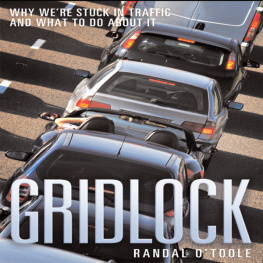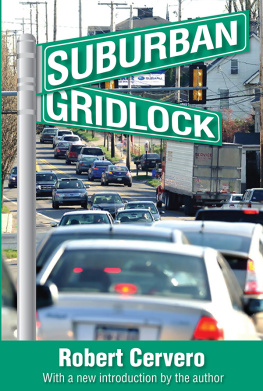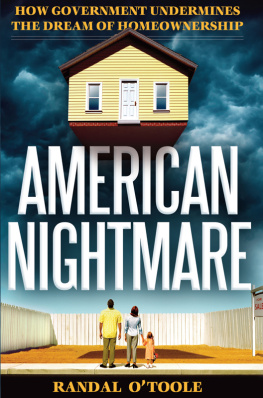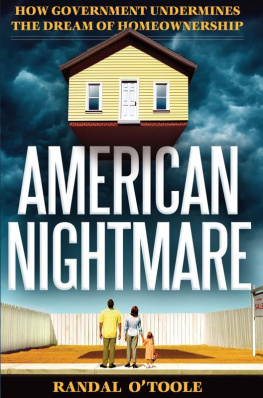Introduction
In 1811, the state of New York laid out much of Manhattan on a grid, with most streets meeting at right angles and blocks as narrow as 200 feet. One hundred and sixty years later, this grid became a source of apprehension among the citys traffic managers. Too many auto drivers ran yellow lights, only to block intersections because of standing or slow-moving vehicles in the next block. If enough drivers blocked cross traffic at enough intersections, traffic managers realized they could end up with a situation in which no one could move. Two city engineers, Sam Schwartz and Roy Cottam, called this fearsome possibility gridlock.1
Urban freeways are very different from city street grids. Because freeways do not form a grid and lack intersections to block, by definition they cannot become gridlocked. Even so, the term gridlock is now commonly applied to all serious traffic congestion. The technical term for such traffic is level of service F, with F clearly representing flunk.2
Millions of commuters and other travelers suffer level of service F every weekday. According to the Texas Transportation Institute, congestion in American cities wasted 4.2 billion hours in 2007.3 This figure is nearly five times as much as 25 years before.4 The institutes numbers focus on commuters and dont even count the costs to businesses, such as the cost of operating more trucks to deliver products in congested areas than would be needed if roads were not congested.
Why do we put up with this? If our cell phones refused to put calls through because the network was busy, we would change carriers. If our high-speed internet service stopped working because too many other customers were using it, we would change internet providers.
One reason we accept congestion on highways is that the government has a monopoly on roads:we can't simply decide to use another highway providers roads. Some of us can decide to ride transit instead of drive, but the government has a monopoly on most transit as well. Partly because of that monopoly, transit for most people simply does not work as well as driving, even on roads at level of service F.
Fifty years ago, Americans boasted of having the best transportation system in the world.5 Today, that system is breaking down. Average urban traffic speeds began declining in 1995 for the first time in our history.6 Bridge collapses and closures generate worries about deteriorating infrastructure. The last real revolutions in transportation technologiessuperhighways and jet aircraftare more than 50 years old. Transportation funding is increasingly politicized, wasting tens of billions of dollars each year on highly visible but little-needed projects. All these problems are exacerbated by a powerful anti-mobility coalition that blames modern transportation for numerous social ills that can allegedly be cured only by reducing personal travel.
Planners and policy analysts have offered many proposals for dealing with this growing congestion: light rail, congestion pricing, compact cities, high-occupancy/toll lanes, high-speed rail, traffic signal coordination, and intelligent highways and vehicles, among others. Some of these proposals will do better than others at relieving congestion, and Gridlock will suggest how we can determine which work best.
The real problem, however, is not technical but institutional. The federal, state, and local government agencies that build and operate our transportation systems have become masters at spending large amounts of money. Yet when addressing problems like congestion, pollution, and safety, they are almost totally dysfunctional. In some cases, Congress has given the agencies so many different and conflicting goals that the simple idea of safe, efficient transportation is almost forgotten. In other cases, the agencies themselves have given up on fixing congestion or even decided that they want more congestion, and they are willfully increasing it in the name of a vague goal they call livability.
Congestion is really just a symptom of this dysfunctional system. So Gridlocks main focus will be on institutional questions. How did transportation agencies change from ones trying to relieve congestion to ones accepting or even promoting congestion? How valid is their view and how much is simply a result of perverse incentives designed into their budgets? How do we change them back? Should we try to reform the agencies or completely abolish them?
If I bring a prejudice to these questions, it is that transportation decisions are best made by individuals who pay the full costs of their choicesa prejudice justified by both theory and experience. My personal transportation preferences are for cycling and trains, butunlike someI dont expect taxpayers to subsidize those preferences any more than if I liked hot-air balloons or miniature submarines.
As an economist who believes in the benefits of free markets, I am tempted to simply argue that we should privatize our roads and transit systems. As an American with faith in the original intent of those who wrote the Constitution, I am also tempted to argue that we should at least abolish federal transportation programs and leave transportation to state and local governments. These are useful ideas and may happen someday.
But I am also a pragmatist who realizes that, except in times of dire emergency, political change tends to be incremental. This book will offer a variety of incremental changes at the federal, state, and local levels that will significantly improve our transportation systems without foreclosing the option for more drastic changes later, should such changes become necessary or feasible.
Any book like this runs the risk of rapidly becoming dated. Between the time I finish writing and the day this book reaches print, the House Transportation and Infrastructure Committee will present its proposal for the next reauthorization of federal transportation spending, the Obama administration will announce which states will receive grants for high-speed rail, and several states may decide to increase gasoline and/or other taxes for transportation. Yet many of the proposals this book make in chapters 10 and 11 will be as valid 20 years from now as they are today or would have been 20 years ago.
These proposals revolve around three simple concepts. First, most of the benefits of a transportation system go to those who use it, so they should be the ones to pay for it. A user-fee-driven transportation system is inherently fair and more likely to be efficient than one funded out of taxes because transportation providers will be forced to design systems to please the users, not systems aimed at capturing the largest share of tax dollars.
Second, when dealing with the social costs of transportation such as pollution, it is essential that we find the most cost-efficient way of reducing those costs. Given a choice between a project that can reduce greenhouse gas emissions at a cost of $10 a ton and one that reduces emissions at a cost of $10,000 a ton, choosing the latter means forgoing 999 tons of emission reductions for every ton abated.












